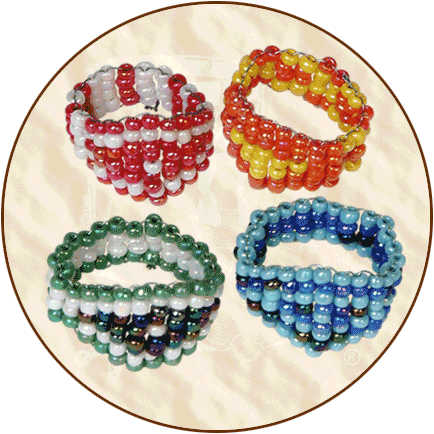.
Continued from product description on
Native American's Page One...
Historical
Background: Beadwork is a hallmark of Native American
cultures. Beads have been recovered from archeological sites
throughout North and South America. The oldest discovered bead
(so far) is made of bone and is 10,900 years old! The next oldest
bead found (again, so far) is 10,100 years old and made of oil
shale. Both beads are quite small (1.6 mm or smaller) and are
so well made, they prove bead making was a sophisticated art
well over 100 centuries ago! This is amazing if one thinks about
the primitive tools they had at that time.
Beads and beadwork played an important part in Native American
societies and their customs. Beads have been part of many tribal
rituals and beliefs. One oral tradition mentions beads as a "supernatural
being," or part of a deity's name. Beads and evidence of
beadwork have been recovered from graves and other burial sites.
Some burial sites had great quantities of beads, suggesting beads
held considerable value for their owners.
A grave with lots of beads also suggests that it is the final
resting place for an important tribal member. Such a grave was
found at Cahokia (near St. Louis, Missouri), a 12th-century Mississippian
site. Three royal Moche-period tombs (100-800 A.D.) discovered
in the Lambayeque Valley of coastal Peru contained magnificent
gold and silver beads. These beads were not just beads, either!
They were highly crafted spiders, owls, human heads, cats, and
even peanuts! Houghton Mifflin's "Encyclopedia of North
American Indians" states that these beads are "some
of the most beautiful and technically sophisticated beads in
the Americas, and perhaps the world." Glass and brass beads
have also been found at Saxon burial sites, in Egyptian tombs,
and within ancient Roman catacombs.
Besides bone, oil shale, gold, and silver, beads have been
fashioned from a variety of natural materials. Beads have been
made from sea shells, stones (including precious and semiprecious
gemstones), ivory, teeth, horn, copper, pearls, plant seeds,
wood, fruit pits, vegetal fibers, clay, tree sap, and animal
quills such as porcupine and bird feathers.
Egyptians were making glass beads by 1365 B.C. There is archeological
evidence that China made and exported glass beads for centuries.
Glass beads were introduced in Venice, Italy, around 1000 A.D.
Venetians held a near monopoly on the glass bead industry for
nearly 600 years, and Venice was regarded as the "Mother
of Trade Beads." In 1291, the Venetian glass industry moved
to the island Murano (north of Venice) because the city fathers
feared a glass furnace accident could destroy the city.
For over two centuries, Murano glass beads were made by a
process called "winding." This method involved drawing
a molten glob of glass out of the furnace and winding it around
an iron rod. The glass could be also be decorated with a design,
or a different colored glass could be added. Coloring agents
were sometimes added to the molten glass. Cobalt was used to
make blue beads, tin gave the glass a milky white color, copper
resulted in green, and gold produced red. Wound beads made by
a master glassmaker were so perfect, it was difficult to find
the seam where different molten glasses merged.
Another method was "blown glass" beads where the
desired shape was obtained by blowing through a glass tube and
into a glob of molten glass. By the way, this method is still
used today to make glassware, such as plates and vases.
These two methods were used until the mid-to-late 1400s. Then
the high demand for glass beads made the winding method impractical.
Many European countries were now sending trade ships around the
world with great quantites of glass beads. Ships' captains and
their passengers would also take glass, porcelain, and metal
beads for trading. And after the discovery of the New World,
the demand for glass beads increased even more.
Glass beads were introduced to the natives of San Salvador
Island on October 12, 1492, by Christopher Columbus on his first
expedition to the New World. Columbus knew well that European-made
glass beads were a successful trade item with natives in Africa
and the Far East; so, he made sure glass beads were on the ships'
manifests of the Niña, Piñta, and Santa Maria.
These Caribbean natives were equally impressed with glass beads
and eagerly traded their handmade goods for them. Some of these
very same beads have been recovered from archeological sites
in the Caribbean.
About the same time Columbus first sailed to the New World,
the Venetians started making glass beads from tubes of drawn
glass. This method had the master glassmaker take a glob of molten
glass and blow it into a cylinder. He then would work the cylinder
into the desired shape, and an assistant would attach an iron
rod to the open end. The assistant would then grab the rod and
run down a long hallway before the glass could cool and harden.
This stretched glass tube could be over 100 meters long!
With this method, the size of the beads was determined by
the length of the tube and the amount of glass used. After cooling,
the glass tube was then cut into shorter lengths. These shortened
tubes were then cut to make different sizes of "tube"
beads. Tube beads were then smoothed by rolling them around in
a large, turning metal drum that contained sand, carbonate, carbon,
and water. As the drum was turned, it was also heated enough
to cause the rough-cut edges to become smooth or rounded. When
done, the smooth glass beads were cleaned and then polished by
being placed in a sack of fermented bran and vigorously shaken.
After Columbus' first landing, glass beads were introduced
to natives throughout the Americas. Along with steel tools, glass
beads quickly became a popular trade item for traders and natives.
Not only were glass beads desired by the natives and profitable
for the traders, but they were extremely lightweight for their
trading value. Weight was an important factor in the days of
wilderness travel. By 1850, practically every tribe in the Americas
had developed a cultural appetite and artistic need for colored
glass beads.
When European traders introduced colored glass beads, American
Indian tribes started to prefer certain colors -- and a shrewd
trader would always know which colors were most desired by each
and every tribe. Colored glass beads were gradually incorporated
into the Indians' bead-making techniques and designs. Eventually,
colored glass beads replaced most of the traditional beads made
from natural materials and strongly influenced the technical
development of beadwork into a new art form. Tribal beadwork
designs and an overall sense for aesthetics also evolved over
this period.
Beads were strung woven, sewn, nettedn and even used as inlay
by Native Americans. Originally, vegetal fiber and mammal sinew
were used to attach the beads. This practice, however, only lasted
until manufactured thread was introduced to Native Americans.
Today, bead making is still a significant part of tribal cultures
in North America and a popular craft enjoyed by the descendants
of European settlers. Historical Folk Toys is pleased to be able
to introduce adults and children alike to the ancient art of
bead making with our Indian Bead Ring Kit (6001).
Fun
Fact: Wampum were belts made with shell beads by the Algonquian
and Iroquoian tribes to record important diplomatic and political
events.
Fun
Fact: The Hudson Bay Company used a standard bead value
for "made beaver" (a pelt that was stretched, dried,
and ready for shipment): six Hudson Bay beads, three light blue
Padre (Crow) beads, and two larger transparent blue beads.
Fun
Fact: The Hudson Bay Company still trades beads today
to Native Americans! They currently stock twelve colors of tiny
seed beads.
Not-So-Fun
Fact: To protect their major export, the Venetians passed
laws that if a skilled glassmaker defected, his closest relatives
would be imprisoned. And if he refused to return to Venice, an
emissary would be sent to kill him!













